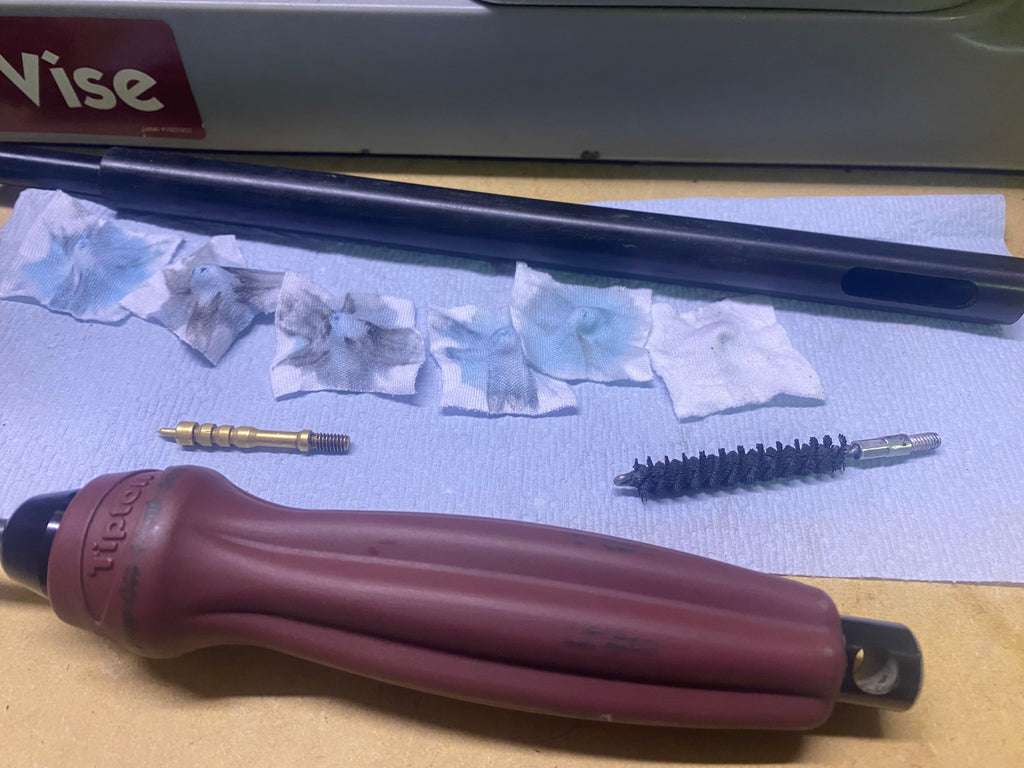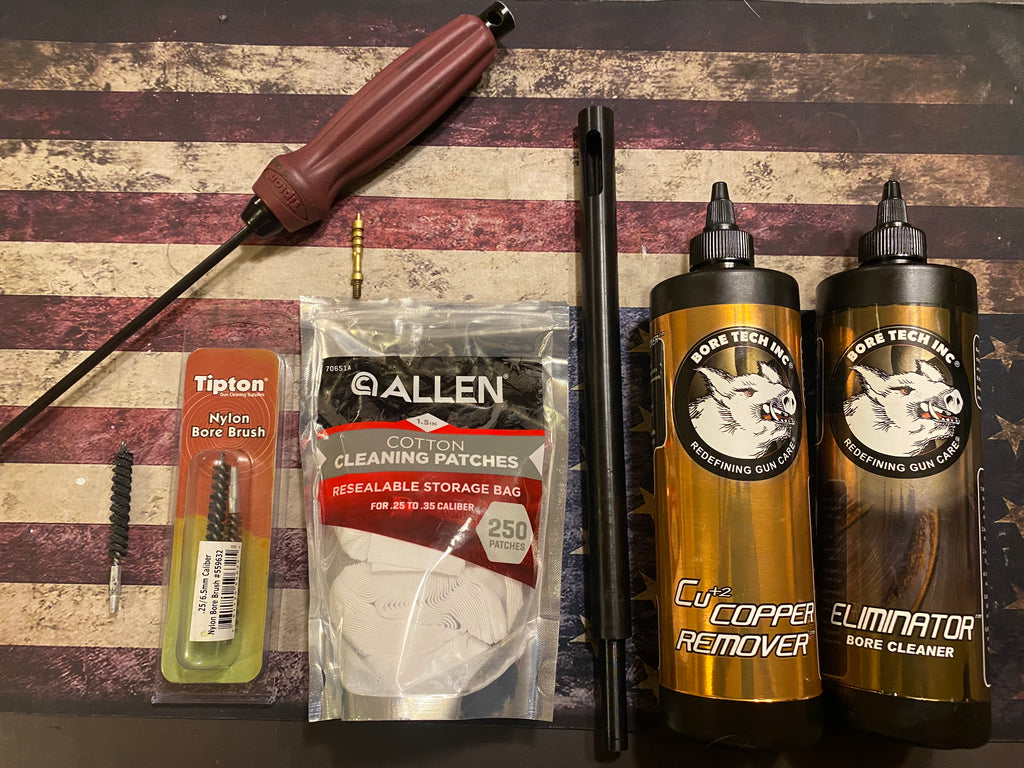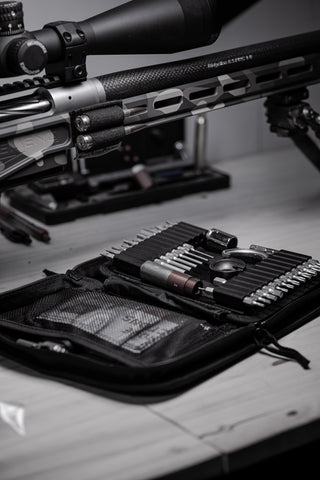Rifle maintenance is critical to the longevity and function of your firearm. Keeping your rifle clean will also increase its accuracy, reliability, and smooth operation. The bore, crown, trigger, and action are vital areas to keep in top-notch condition. Keeping the bore and crown clean gives you a more accurate rifle. A clean trigger will ensure your rifle is as reliable as possible. A clean action will ensure the bolt is smooth and maintain reliable feeding of cartridges into the chamber. Each part requires different processes and tools to achieve the task, and this article will guide you on how to clean a rifle the right way.

Top 3 Rules of Cleaning a Rifle
- Keep ammo away - Keeping ammo in the safe is the easiest way to ensure everyone stays safe while you are cleaning your rifle. If you need to use ammo to check the rifle once cleaning is done, consider using a spent piece of brass instead of live ammo. If that is not an option, ensure the rifle is pointed in a safe direction and consider pulling the firing pin to be on the safe side.
- Lube necessary areas - You want to lube high friction areas on the rifle with gun grease. This includes the back of the bolt lugs, raceways, and camming surfaces. By lubing these with grease, you ensure those areas will stay smooth and not gall. It's important to apply the correct amount and wipe away any excess. Excess grease will allow dirt to get into those high-stress areas.
- Oil for rust prevention - Although oil can be a lubricant, consider mainly using it for wiping down parts to prevent rusting. In preparation for any use in wet climates, it’s a good idea to simply wipe down exposed steel with oil beforehand and then after when you return it to the safe.
Cleaning Components
Barrel Cleaning
Before cleaning your barrel, you should ensure you have the appropriate tools. You will need a one-piece carbon cleaning rod, a brass jag, a nylon bore brush, patches, a bore guide, and a cleaning solvent. All of these can be found in different sizes and designs, making sure the correct fit is used for the rifle(s) you are cleaning. Start with the jag and a dry patch covered in your preferred cleaning solvent.
- You will want to push a solvent-soaked patch through so the solvent can start activating.
- Now, you will use the nylon brush to loosen the material in the barrel. I like to use 10-20 strokes when using the brush.
- Once the material is loose, you can push 2-3 patches to remove the material.
- Repeat steps 2 and 3 until you have a clean bore showing no carbon signs. The image below shows different stages of cleaning patches.
- Once the bore is clean, use a few dry patches to remove the solvent from the chamber and bore.
Typically, this cleaning process takes little time and will give you the results you are looking for.
Bolt Cleaning
Cleaning your bolt is often a step that is neglected. If the inside of your bolt gets dirty, it can negatively impact the reliability and accuracy of your rifle. The first step to cleaning your bolt is taking it apart. Remove the firing pin from the bolt body so you have access to your cocking piece and firing pin assembly. Once you reach this point, you should wipe off debris from the firing pin and firing pin spring. You can clean between the spring coils with a Q-tip or cotton ball. Once you have the spring and firing pin clean, you should remove any carbon from your cocking cam and lube at that point. Reference the bolt cleaning video for visual tips on cleaning the bolt and the appropriate areas to clean and lube.
Action Cleaning
Cleaning your action is essential to maintaining a smooth and reliable rifle. When cleaning an action, you should start by removing the bolt so you can access the inside of the action. Once you do so, you can use Q Tips to remove dirt from the action. It helps to spray a small amount of oil into the action before using Q Tips. Once you clean all the dirt from the action, you can put a tiny amount of grease on the raceways, allowing the action to be “smooth as butter.”
Rifle Trigger Cleaning
While cleaning the action, you should also clean the trigger. Different triggers will require different cleaning processes. A contained trigger housing like a Triggertech will only allow you to clean the sear, while other triggers can have the internals cleaned. You only need an alcohol-based cleaner like Ronsonol lighter fluid or Colman White Gas. Soak the trigger in this solvent, allowing it to remove dirt and debris. Allow the trigger to air dry for a bit before re-installing. The options mentioned will evaporate quickly. You should clean your trigger annually and possibly more often, depending on how often it is used and the environment. Keeping a clean sear engagement to have a safe and dependable rifle can be done frequently and, on many models, does not require you to remove the trigger housing from the action. Do not apply any oils to the trigger.
Magazine Cleaning
Magazine cleaning is the last process that often gets overlooked. A dirty magazine will increase the friction on the follower, causing inconsistent feeding. To clean the mag, you should pull it apart and use a brush to scrub the inside of the box and clean the follower. The best way to achieve this is by using a nylon brush and scrub under running water. Once you have all the dirt and brass cleaned out of the magazine, you should spray some oil on a rag and rub down the magazine and spring to keep any rust from arising.
Solvents, Cleaners, and Tools

There are many different cleaning solvents to choose from when cleaning your rifle. Some of them allow you to clean quicker than others, while others can harm your rifle's long-term performance. The most popular bore cleaners are
- Copper Remover
- Carbon Remover
- Two in one (carbon and copper fouling removers)
- Abrasives
Every experienced shooter has their favorite cleaning solvent, which will change depending on who you talk to. Personally, I prefer to use a two-in-one like Boretech Eliminator, but I have also tried abrasives and copper and powder fouling removers in the past, and they have worked great. Try out a few different cleaners, consult your rifle builder, and see what works best for you.
Popular solvents include Boretech, Hoppes, JB Bore Paste, CLP, Barnes CR 10, and many more.
Quality cleaning solvents are essential to the process, but you also need to choose quality tools like a cleaning rod, bore brush, dry and wet patches, paper towel, and jags. Here is a list of some of our favorite cleaning components on the market.
- Cleaning rod -Tipton,Breakthrough,Dewey
- Bore brush - Tipton,Boretech,Hoppes
- Patches - Hoppes,Boretech,Birchwood
- Jags - Tipton,Bortech,Hoppes
Quality-cleaning components will ensure you do not damage the bore of your rifle while cleaning. Unfortunately, this is more common than shooters believe, and without a good borescope, you cannot see the long-term damage from poor components. Get the best components possible and make sure they are appropriate for the rifle you are shooting.
Lubrication and Preservation
Lubrication and preservation are two very important steps for the longevity of your rifle. Lubrication allows your rifle to function smoothly and reliably while in use. Preservation maintains the rifle's current state while the rifle isn't in use. Although they are similar processes, the clean-up process changes.
Lubrication- When lubricating your rifle, spray the lubricant on the rifle and wipe off any excess. Removing the excess will ensure that dirt and dust won't stick to the rifle parts and harm how the rifle functions. Rifle lubrication includes greasing the bolt’s locking lugs, spraying the bolt body with oil, and wiping down any outside parts exposed to the elements.
Preservation- To preserve your rifle, you should spray lubricant on all metal portions of the rifle. Instead of wiping off all the excess oil, this time, spread it out along the rifle's parts. It should not be dripping off the rifle but a good coat to preserve it for a long time. This is the best preservation for long-term storage of rifles, so it stays in pristine condition for the lifetime of the rifle. I prefer Lucas Extreme Duty Gun Oil,Birchwood Gun Oil, or Rem Oil for lubrication and preservation.
Safety precautions need to be taken seriously while you are cleaning your rifles. You need to ensure the rifle is safe and keep yourself safe from cleaning solvents during use and storage. The first step while handling your rifle should always be to ensure it's unloaded and safe. You should move on to cleaning solvent safety once you take the proper rifle safety steps. When cleaning rifles, you should always;
- Wear eye protection
- Wear gloves
- Try not to breathe the solvent fumes
- Store safely
Steps 1-3 are self-explanatory, but safely storing your cleaning solvents is important. Solvents must be stored in a cabinet that is out of reach from children. Store them in a plastic bag to ensure they do not spill if tipped over. Solvents can contain toxic materials harmful to skin, eyes, or even fumes, so be careful while using or handling them.
Maintenance Schedule
Routine cleaning schedules make sure your rifle maintains its utmost performance. A cleaning schedule can include two methods: routine and deep cleaning. Routine cleaning should be performed every time you use the rifle. Deep cleaning schedules should be performed on a timely or used basis. For example, my cleaning schedule on competition rifles is a deep clean every 200 rounds and routine cleaning after every use. My deep clean includes thoroughly cleaning the bolt, cleaning all carbon out of the barrel, cleaning carbon off the crown, and cleaning my trigger. This routine makes sure my rifle is performing perfectly for all match scenarios.
Rifle Maintenance in the field

If you take care of your rifle, field maintenance should be minimal. It is still a good idea to be prepared for the worst so you can stay on the mountain. Rifle cleaning kits like the XLR- Fix it Stick Long Range All-in-One package will keep you on the mountain if an issue arises. Some common field fixes that I have seen performed have been
- Torquing screws (action screws, scope ring screws, and scope base screws)
- Clearing dirt and snow from the barrel
- Cleaning water out of the chamber
These are different cases that I have had to perform personally, and I have been pleased to have my tool kit with me when the issue comes up. When driving on bumpy roads in a truck or RZR, it is a good idea to check all screws to ensure your rifle can still perform at its peak. In subpar conditions, people can fall and get dirt or snow in their barrel or muzzle brake. A small compact cleaning rod can come in handy at that point.
Rifle maintenance is vital to preserving your rifle in its highest-performing state. It is straightforward if you take the correct precautionary steps while cleaning your rifle. Make sure you are familiar with your rifle and how to break it down at the house and in the field. Lastly, ensure a way to address the rifle in the field. If you have all of those steps nailed down, you should be able to keep a rifle performing how you expect and have a successful hunt, match, or day at the range.
Are you ready to clean your rifle like a pro?
Follow this comprehensive guide to rifle maintenance and ensure your firearm's longevity and peak performance. For quality rifle components and accessories, explore XLR Industries. Contact us at info@xlrindustries.com or give us a call at 970-241-1807 for expert guidance. Get your rifle maintenance game on point with XLR Industries today!
